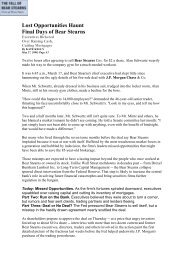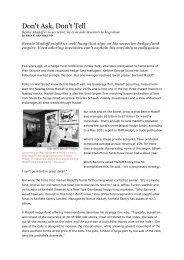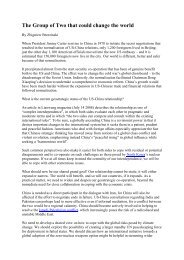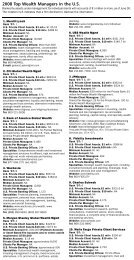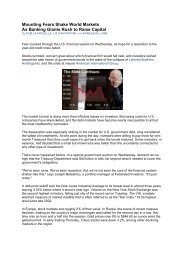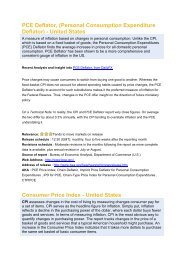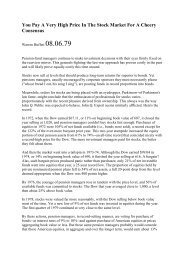As Credit Crisis Spiraled, Alarm Led to Action - Morningbull
As Credit Crisis Spiraled, Alarm Led to Action - Morningbull
As Credit Crisis Spiraled, Alarm Led to Action - Morningbull
You also want an ePaper? Increase the reach of your titles
YUMPU automatically turns print PDFs into web optimized ePapers that Google loves.
Panic was spreading on two of the scariest days ever in financial markets,<br />
and the biggest inves<strong>to</strong>rs — not small inves<strong>to</strong>rs — were panicking the most.<br />
Nobody was sure how much damage it would cause before it ended.<br />
This is what a credit crisis looks like. It’s not like a s<strong>to</strong>ck market crisis,<br />
where the scary plunge of s<strong>to</strong>cks is obvious <strong>to</strong> all. The credit crisis has<br />
played out in places most people can’t see. It’s banks refusing <strong>to</strong> lend <strong>to</strong><br />
other banks — even though that is one of the most essential functions of the<br />
banking system. It’s a loss of confidence in seemingly healthy institutions<br />
like Morgan Stanley and Goldman — both of which reported profits even as<br />
the pressure was mounting. It is panicked hedge funds pulling out cash. It is<br />
frightened inves<strong>to</strong>rs protecting themselves by buying credit-default swaps<br />
— a financial insurance policy against potential bankruptcy — at prices 30<br />
times what they normally would pay.<br />
It was this 36-hour period two weeks ago — from the morning of<br />
Wednesday, Sept. 17, <strong>to</strong> the afternoon of Thursday, Sept. 18 — that spooked<br />
policy makers by opening fissures in the worldwide financial system.<br />
In their rush <strong>to</strong> do something, and do it fast, the Federal Reserve chairman,<br />
Ben S. Bernanke, and Treasury Secretary Henry M. Paulson Jr. concluded<br />
the time had come <strong>to</strong> use the “break the glass” rescue plan they had been<br />
developing. But in their urgency, they bypassed a crucial step in<br />
Washing<strong>to</strong>n and fashioned their $700 billion bailout without political<br />
spadework, which led <strong>to</strong> a resounding rejection this past Monday in the<br />
House of Representatives.<br />
That Thursday evening, however, time was of the essence. In a hastily<br />
convened meeting in the conference room of the House speaker, Nancy<br />
Pelosi, the two men presented, in the starkest terms imaginable, the outline<br />
of the $700 billion plan <strong>to</strong> Congressional leaders. “If we don’t do this,” Mr.<br />
Bernanke said, according <strong>to</strong> several participants, “we may not have an<br />
economy on Monday.”<br />
Setting the Stage<br />
Wall Street executives and federal officials had known since the previous<br />
weekend that it was likely <strong>to</strong> be a difficult week.




